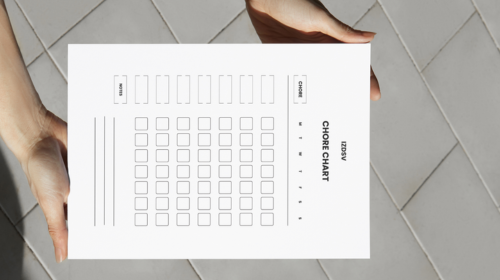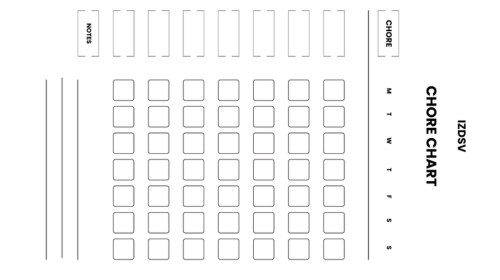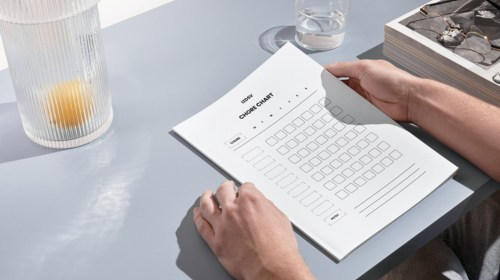Printable Chore Chart: Your Ultimate Guide to Organizing Household Tasks
What is a Printable Chore Chart?
A printable chore chart is a customizable, visual tool designed to assign specific tasks to various household members. It typically includes a grid or schedule where you can list daily, weekly, or monthly chores, and assign them to different individuals.
Why Use a Chore Chart?
- Encourages Responsibility: By clearly outlining tasks, chore charts promote a sense of responsibility and accountability among all household members.
- Improves Organization: A well-structured chore chart helps maintain a tidy and organized home by ensuring that tasks are completed regularly.
- Teaches Life Skills: Assigning chores to children can teach them valuable life skills, such as time management, problem-solving, and cooperation.
- Reduces Conflict: A clear division of labor can help prevent arguments and misunderstandings about household responsibilities.
- Promotes Teamwork: Chore charts can foster a sense of teamwork and cooperation among family members.
Who Can Benefit from a Printable Chore Chart?
- Families: Chore charts are particularly useful for families with children of all ages.
- Housemates: For individuals living together, a chore chart can help ensure that everyone contributes to maintaining the shared living space.
- Individuals: Even if you live alone, a chore chart can help you stay organized and prioritize tasks.
How to Create an Effective Printable Chore Chart?
Elements to Include in Your Chore Chart
- Clear Labels: Use simple and easy-to-understand labels for each chore and the individuals responsible.
- Weekly or Daily Schedule: Determine whether a weekly or daily schedule works best for your household and design the chart accordingly.
- Task Descriptions: Provide clear and concise descriptions of each chore to avoid misunderstandings.
- Checkboxes or Boxes: Include a system (like checkboxes or boxes) for marking completed tasks.
- Rewards or Consequences: Consider adding a section for rewards or consequences to motivate adherence to the chart.
Assigning Chores Fairly
- Age and Abilities: Consider each individual’s age and abilities when assigning chores.
- Interests: Try to assign chores that align with each person’s interests or strengths.
- Rotating Chores: Rotate chores regularly to ensure fairness and prevent boredom.
- Family Meetings: Discuss chore assignments as a family to promote understanding and buy-in.
Design Features for Engagement
- Visual Appeal: Use bright colors and eye-catching graphics to make the chart more appealing.
- Personalization: Allow individuals to customize their own sections of the chart, such as choosing their favorite colors or adding stickers.
- Gamification: Incorporate game-like elements, such as points or rewards, to make completing chores more fun.
- Flexibility: Design the chart to be adaptable to changing schedules or needs.
How to Customize Your Printable Chore Chart?
Tools for Customization
- Online Template Generators: Websites like Canva, Adobe Express, and Piktochart offer customizable chore chart templates with a variety of design options.
- Microsoft Word or Google Docs: You can create a basic chore chart using these word-processing tools and customize it with fonts, colors, and images.
- Drawing Apps: If you’re more creative, you can use drawing apps like Procreate or Adobe Illustrator to design your own unique chore chart.
Incorporating Rewards
- Reward System: Create a reward system tied to completing chores. For example, you could offer points for completing tasks, which can be redeemed for privileges or treats.
- Visual Rewards: Use stickers or stamps to visually track progress and reward completed chores.
- Family Rewards: Consider family-wide rewards for achieving goals or maintaining a clean and organized home.
Popular Themes and Designs
- Seasonal Themes: Use seasonal themes (e.g., winter wonderland, summer beach) to keep the chart fresh and engaging.
- Character Themes: Choose a favorite character or theme (e.g., superheroes, or princesses) to make the chart more appealing to children.
- Educational Themes: Incorporate educational elements, such as vocabulary words or math problems, to make chore time more engaging.
- Minimalist Designs: For a simpler look, opt for a minimalist design with clean lines and neutral colors.
How to Implement a Printable Chore Chart at Home?
Introducing the Chore Chart
- Family Meeting: Gather your family together and explain the purpose of the chore chart. Emphasize the importance of sharing responsibilities and contributing to a positive home environment.
- Assign Chores: Work together to assign chores based on age, abilities, and interests. Consider rotating chores regularly to keep things fair.
- Set Expectations: Clearly communicate expectations regarding the frequency and quality of completing chores. Discuss any consequences for not following the chart.
Keeping Kids Motivated
- Positive Reinforcement: Praise children for completing their chores and reward good behavior.
- Make it Fun: Incorporate games or challenges to make chore time more enjoyable.
- Set Small Goals: Break down larger chores into smaller, more manageable tasks.
- Involve Kids in the Process: Allow children to help create the kids chore chart or choose their own chores.
Dealing with Non-Compliance
- Open Communication: Talk to the child calmly and respectfully about the issue. Try to understand their perspective.
- Review Expectations: Remind the child of the expectations and consequences for not following the chart.
- Offer Support: If the child is struggling, offer assistance or guidance.
- Adjust the Chart: If necessary, reevaluate the chore assignments and make adjustments to better suit the individual’s needs.
What Are the Advantages of Using a Printable Chore Chart?
Promoting Responsibility in Children
- Clear Expectations: A chore chart provides children with clear expectations about their responsibilities, helping them develop a sense of accountability.
- Skill Development: Completing chores helps children learn valuable life skills, such as time management, problem-solving, and independence.
- Self-Esteem Boost: Recognizing and appreciating a child’s contributions can boost their self-esteem and confidence.
Impact on Family Dynamics
- Improved Communication: A chore chart can open up lines of communication about expectations, responsibilities, and fairness within the family.
- Reduced Conflict: By clearly defining roles and responsibilities, a daily chore chart can help prevent arguments and misunderstandings.
- Stronger Bonds: Working together as a family to complete chores can strengthen bonds and foster a sense of unity.
Reducing Household Stress
- Organization: A chore chart helps keep track of tasks and ensures that responsibilities are evenly distributed, reducing feelings of overwhelm.
- Peace of Mind: Knowing that chores are being completed regularly can provide a sense of peace and satisfaction.
- Preventative Measures: By addressing potential conflicts and misunderstandings upfront, a simple chore chart can help prevent future stress and tension.
What Are Some Creative Ideas for Using Chore Charts Beyond the Basics?
Beyond the Basics
- Learning Opportunities: Incorporate educational elements into the printable chore chart for kids, such as vocabulary words, math problems, or historical facts.
- Skill Building: Focus on specific skills, like organization, time management, or problem-solving, and assign simple chores that help develop these abilities.
- Goal Setting: Create a long-term goal (e.g., saving for a vacation) and assign weekly chore chart goals that contribute to achieving that main goal.
Special Events and Holidays
- Seasonal Themes: Design fun chore charts with themes related to holidays or seasons (e.g., Halloween, Christmas, summer).
- Special Tasks: Assign special tasks related to the event (e.g., decorating, cleaning up after a party).
- Rewards: Offer extra rewards or privileges for completing chores related to special events.
Variations for Different Age Groups
- Toddlers: Use simple pictures or symbols to represent chores. Offer praise and encouragement for completing tasks.
- Elementary School Children: Create a game-like chore chart with points or rewards. Use colorful designs and fun illustrations.
- Teenagers: Allow teenagers to have more input into the chore chart design and assignments. Consider offering more flexible schedules or options.
Using Technology
- Digital Chore Charts: Use apps or online tools to create digital chore charts that can be accessed on smartphones or tablets.
- Gamification: Incorporate game-like elements, such as points, badges, or leaderboards, to make completing chores more engaging.
- Automation: Explore smart home devices or automation tools to streamline chores and make them more efficient.



